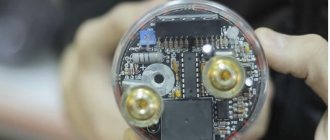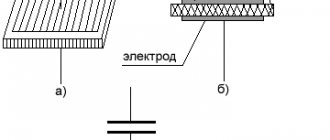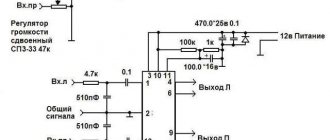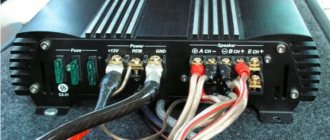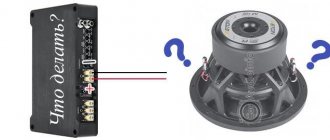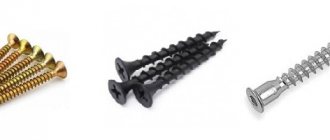Many lovers of powerful low-frequency loudspeakers face the same problem. At peak power, when the bass frequencies should sound at full strength, there is a decrease in the volume of the sound until it disappears completely. This lasts a short period of time, but significantly affects the quality of the musical fragment. A car battery produces constant voltage over a short period of time. Typically this is 13.8-14.8 volts. No battery can produce a higher voltage level.
A powerful car low-frequency system, with an output power of hundreds of watts, at moments of maximum volume consumes a very large current, while what the battery produces is simply not enough. Why do you need a subwoofer drive - to be able to add energy to the amplifier. A large capacitor is used as an additional power source. It can be from half to several farads. Capacitors for a subwoofer in a car are not just an energy storage device, but an electronic device with a microchip and an LED indicator.
Operating principle and purpose
The operation of a capacitor for acoustic systems is based on the law of conservation and accumulation of energy of the simplest element found in many electrical circuits. The simplest capacitor consists of two conductors with a dielectric between them. The length of these conductors, depending on the capacity, can reach from one meter to several tens, as well as the dielectric located between them. This entire design is very compact, so even with such a huge capacitance for electronic devices as one Farad, the dimensions of the capacitor for the subwoofer allow it to be placed in a car.
The principle of operation of a car capacitor connected to the power circuit of an amplifier or subwoofer is that in normal mode, when the supply voltage is at least 12 Volts, it is capable of accumulating an electrical charge. When a fan of loud music turns up the regulator and increases the power of the audio system, the current in the power circuit increases greatly and can reach up to 100 Amps, and a voltage drop occurs, since neither the generator, nor, especially, the battery is designed to work with such a large constant load. Moreover, in the car circuit, especially at night, there is already a load caused by the switched on lighting devices, wiper motor, air conditioning and other devices, depending on the configuration of the car’s electrical equipment. When listening to powerful bass, the acoustic capacitor for the subwoofer will compensate for the decrease in the supply voltage, that is, its drawdown. Without this device, the voltage at some points will drop to 8-9 Volts, which is unacceptable both for installed stereo systems and for the entire on-board circuit of the car.
Thus, we can identify several obvious signs that will be noticeable to the driver due to the absence of a high-capacity capacitor in the subwoofer power circuit:
- Flashing headlights in time with the music;
- Increased fuel consumption associated with increased load on the generator;
- Disabling or significantly reducing the sound quality of the audio system with increasing power and especially with strong low frequencies emitted by the subwoofer.
Methods for selecting a capacitor for powerful speaker systems
In order to choose the right acoustic capacitor for a subwoofer
you need to take into account the maximum and operating power of the sound amplifier. For 1000 W of stereo system power, a capacitance in its power supply circuit is required equal to 1 Farad. This is a very large capacitance that can compensate for the voltage drop; mainly in electronics you can find capacitors whose capacitance is measured in microfarads.
Also required for stable operation of the system is an electronic circuit built into the device body, designed for:
- voltage indication in the amplifier power circuit;
- supplying energy from a backup energy source (capacitor) at the desired peak moment of drawdown;
- adjusting the amount of energy to protect against blown fuses.
An acoustic capacitor for the subwoofer is connected in parallel to the power circuit, being sure to observe polarity and minimize its distance from the amplifier terminals.
Review of the most common acoustic capacitors
Brax IPC
- from connection with incorrect polarity;
- from overvoltage, that is, if the voltage rises above 17.5 Volts.
It is equipped with a bright three-digit indication of the voltage value of the amplifier supply circuit, which displays the average value for a time of 1.5 seconds, which is very pleasant and distinguishes this model from cheaper ones. There is also an indication that the protections described above are enabled.
Power Ampere SPV 100D
Signat ECC1
. Listed market price $230. It is compact, since its diameter is 7 cm. The process of fully charging the acoustic capacitor is notified by 5 LEDs of different colors. Charging time and ability to work in normal mode is about 1.5 minutes. An emergency shutdown occurs when the supply voltage on the subwoofer increases to 16.5 V.
Thus, lovers of creating powerful car audio will have to fork out for another necessary tool to obtain high-quality sound and maintain the car’s on-board voltage system in normal mode.
Top 5 devices of 2022
Based on consumer reviews, the 5 best capacitors for a subwoofer have been selected, showing good results and a long service life. These include products from well-known brands, suitable for use by both novice and experienced car audio engineers.
Kicx flc 1.5
pros
- good equipment
- contacts for ring terminals
- reverse polarity protection
- charge level indication
Minuses
- weight, dimensions
- capacity is only 1.5F
- low operating voltage margin
From 2339 ₽
The main advantage of this capacitor is its complete ease of installation. Convenient complete brackets and a reliable contact group are provided. The product shows excellent service life thanks to electronic protection and a special mesh.
MD.Lab PC-E1.0
pros
- 1F capacity with small measurement error
- compact aluminum housing
- built-in voltmeter
Minuses
- no reverse polarity protection
- small margin for maximum voltage
- poor equipment (only capacitor)
From 2240 ₽
This drive can only provide 18 V pulse voltage. If this is enough, the device will appeal to experienced audio system designers. The capacitor can operate at temperatures from -40 to 60 degrees Celsius and has low leakage currents.
ACV CAP-5.0F
pros
- overload protection
- protection against incorrect activation
- amplifier integration option
- possibility of connecting several series-connected load units
- advanced electronic parameter control system
- indicator light and built-in voltmeter
Minuses
- dimensions
- low pulse voltage value
- own connection diagram
- awkward terminal blocks
From 3875 ₽
The most complete control of voltage and operating parameters available today, as well as the possibility of direct control from the amplifier are two striking features that distinguish this capacitor model. It will appeal to users who want to create a truly powerful system. A capacity of 5F is enough for acoustics of 5 kW.
Why do you need a capacitor for a subwoofer?
Fans of loud, high-quality music with powerful bass often encounter problems when sound drops occur in certain situations. In such cases, there is no need to risk breaking the subwoofer or speakers.
Let's go back to school physics lessons somewhere in the seventh grade. , when playing powerful bass, it can briefly consume current that even the strongest battery cannot provide. The wires connecting the subwoofer and the amplifier, even if they are very thick, have resistance, which at the peak of the signal leads to a decrease in voltage. At these moments, the so-called sound failures occur. It is at such moments that a capacitor for a subwoofer is needed. It is a high-capacity electrolytic device that is connected in parallel to the amplifier and car battery. When connecting nodes in parallel, during current peaks, the device absorbs excess voltage, which helps smooth out the so-called dips of the subwoofer. Due to the very low internal resistance of the capacitor itself, it charges in a split second and absorbs subsequent voltage surges.
What equipment capacity is needed?
There is no exact formula here. Many follow this rule: 1 kW. from the power of the amplifier must correspond to 1 F of the capacitor capacitance. This is normal and most users purchase the design precisely for this reason. For example, if your car has an audio system with a power of 2 kW, then you need to purchase a drive with a capacity of 2 Farads. But experts recommend choosing a device with a large supply of capacity.
Subwoofer amplifier and capacitor
Some models have built-in voltmeters. They control the system voltage level. Devices with voltmeters are more expensive.
Main characteristics
The subwoofer drive is used not only in high-end audio systems, but also in conventional ones. This technique can significantly improve the properties of the amplifier. Modern subwoofers consume quite a lot of electricity at peak moments of the audio signal. Even the most advanced battery cannot quickly supply significant current. The gadget in question is used to solve this problem.
Also, do not forget about the operation of other electrical appliances in the car. For example, an air conditioner, which can absorb up to thirty percent of the energy generated by the generator. This often leads to sound distortion, especially when delivering powerful bass. A car subwoofer drive solves this problem. It is an electrolytic type capacitor, the capacity of which is sufficient to accumulate electric current. This device is used to supply energy to the subwoofer.
The equipment is installed in close proximity to the amplifier. It is often equipped with voltmeters and charge indicator lights. The equipment set includes everything necessary for installation. Note that the capacitor and amplifier should be located at a distance of no more than fifty centimeters. The connectors of the equipment in question are most often gold-plated. This is necessary to reduce resistance as much as possible. The operating voltage of the equipment can reach twenty-four volts.
From us you can buy a subwoofer drive of various models. Our specialists will help you choose the device that best suits your audio system. The price of a gadget directly depends on its characteristics and the company offers a wide range of these devices. Therefore, choosing a subwoofer storage capacitor will not be difficult at all.
Showdowns with ceramics
Ceramic capacitors are the nastiest of them all. Nothing is known about them in advance - after all, capacitors of the same type can be made from different ceramics with completely different properties! There is a “law of the lever of the universe”: when you win in one thing, you usually lose in something else. In ceramic capacitors, while gaining in size, they lose in thermal stability and linearity, because Ferroelectric ceramics are used as a dielectric. Moreover, according to technical conditions, only TKE (temperature coefficient of capacitance) is standardized, but linearity seems to be of no interest to anyone. And it is widely believed that thermostable capacitors are linear, but non-thermostable ones...
But it turns out that thermostable ceramic capacitors are very, very nonlinear. I scraped together a handful of capacitors and continue to measure them. This time I will try to find a connection between the linearity of a capacitor and its other properties. Unfortunately, the type of capacitors continues to remain unknown (with the exception of K10-17a), so here is their group portrait (next to each is a serial number, and capacitors of the same capacity of different types are double numbered). Capacitances from 1 µF to 750 pF.
I assumed that the linearity of capacitors should depend on their capacitance (after all, it’s easy to get a small capacitance with small dimensions; for a large capacitance you have to dodge, stuffing it into a small case), type and size (well, it’s also clear here: if you don’t need to miniaturize, we install high quality ceramics). This especially applies to capacitors K10-17a - they “fit” capacitances from 100 pF to 1 µF in identical cases!!! And in cases of different sizes, the “crystals” of the capacitors themselves are also different (both capacitors are 0.1 µF; the exact same ones are being studied here, their numbers are 2-5 and 2-3):
In addition, capacitors of different types (and the industry produces countless types of these! And it is not clear what the difference between them is, in reference books there is not much information on this topic) may have different properties.
Important! All capacitors are measured under almost the same conditions (voltage/frequency)!
Therefore, we summarize all the measurements in a general table (Attention! the photo in the table is not scaled! For actual dimensions, see the general photo!).
| No. | Capacity | Appearance | Kg, K'g | Distortion spectrum (in%) | TKE, %/degree |
| 1-1 | 1 µF | Kg = 2.7% K'g = 6.5% | -1,7 | ||
| 1-2 | 1 µF | Kg = 0.64% K'g = 2.2% | -1,15 | ||
| 1-3 | 1 µF | Kg = 0.51% K'g = 1.15% | -1,05 | ||
| 2-1 | 0.1 µF | Kg = 1.57% K'g = 4.3% | -0,59 | ||
| 2-2 | 0.1 µF | Kg = 0.68% K'g = 1.4% | -1,4 | ||
| 2-3 | 0.1 µF | Kg = 0.44% K'g = 1.16% | -1,73 | ||
| 2-4 | 0.1 µF | Kg = 0.51% K'g = 1.27% | -1,15 | ||
| 2-5 | 0.1 µF | Kg = 0.026% K'g = 0.057% | -0,18 | ||
| 3-1 | 0.022 µF | Kg = 1.17% K'g = 6.5% | — | ||
| 3-2 | 0.022 µF | Kg = 0.88% K'g = 2.1% | — | ||
| 3-3 | 0.022 µF | Kg = 0.16% K'g = 0.36% | -0,094 | ||
| 4 | 10 nF | Kg = 0.08% K'g = 0.18% | -0,078 | ||
| 5 | 5.6 nF | Kg = 0.0023% K'g = 0.009% | -0,1 | ||
| 6 | 3 nF | Kg = 0.0018% K'g = 0.007% | — | ||
| 789 | 2.4 nF1.5 nF750 pF | Kg = 0.0017% K'g = 0.007% | — |
I did not measure the TKE values for all capacitors, but these numbers are enough for preliminary conclusions. The minus sign means that as the temperature rises, the capacity decreases.
Connecting a capacitor to a subwoofer
When choosing a capacitor for a subwoofer, you need to pay attention to the presence of a voltmeter, which allows you to measure the current performance of this element. In high-quality capacitor models, the connectors for connecting the amplifier are in most cases gold-plated, which minimizes electrical losses and reduces resistance in the electrical circuit
In high-quality capacitor models, the connectors for connecting the amplifier are in most cases gold-plated, which minimizes electrical losses and reduces resistance in the electrical circuit.
In most cases, the subwoofer is placed under the seat, and the electrolytic capacitor is placed in the trunk near the amplifier. It is believed that the distance between the capacitor and the amplifier should not exceed 50 centimeters.
In this case, the appearance of this element will be important. As a rule, they consist of several completely transparent glass flasks. Today you can find numerous models of automobile acoustic bulbs on sale.
They differ in the components used, the eclectic capacity indicator and their appearance. We recommend choosing products from those manufacturers who specialize in the production of car acoustics, which will allow you to make the right choice.
To equip your car with a good audio system, you need to take into account all the nuances. You must definitely buy a drive for your car with sufficient power. This equipment will allow you to “squeeze” the maximum out of the audio system and make the sound high-quality and pleasant to the ear. Below we will talk in detail about this technique.
Additional benefits
Connecting a capacitor will bring a number of additional bonuses:
- filtering of high-frequency components of mains voltage, which has a positive effect on the operation of electrical systems and vehicle devices;
- preventing sudden voltage surges when the on-board electrical equipment is turned on reduces the overall load on the network and promotes smoother battery operation;
- assistance in starting the car using a starter, which is especially important in cold weather.
The main advantage of installing the device will be the normalization of low frequency reproduction, clear sound without interference or distortion.
Correctly setting up a subwoofer in a car
Review of capacitors for a snack
Brax IPC
Capacitor costing 300 US dollars. The model name IPC stands for “intelligent power capacitor.” It has the following features:
- The user will find in this model a luxurious, superbly finished, clearly thought out device with the highest electrical performance;
- The length of the capacitor body is 280 mm, and the diameter is 75 mm;
- The operating principle is based on automation, which will provide charging with a normalized current and protect the acoustics from overvoltage;
- The Brax capacitor operates at 17.5 V, if connected incorrectly, automatically connected to the power network and disconnected;
- Provides continuous indication of voltage at the amplifier terminals (see);
- The capacitor is made in a stylish, beautiful case with a transparent head, in the center of which a 3-charge digital indicator is displayed. This indicator becomes active as soon as it senses the slightest voltage ripple on the amplifier and shows a voltage of up to 0.1 V;
- The capacitor readings are not carried out by continuous blinking, as on some cheap models, but are averaged with a time constant of about 1.5 s;
- For rapid fluctuations, the answer is another indicator, operating on 2 LEDs. If one of them or two blinks at once, this indicates short-term voltage ripples;
- There is also a third indicator called CPS. It is needed to report danger: if it lights up red, the polarity is reversed; if it lights up yellow, the overvoltage protection has tripped.
For you, audiophiles!
Today we will look at “audiophile” capacitors. This is quite a difficult matter - after all, some believe that the best capacitors are Telefunken, obtained from receivers produced in Germany between 1934 and 1944 (i.e. under Hitler). Some people believe that you need to wind the capacitors yourself from silver foil and the “correct” dielectric on the 13th on the new moon, turning your face to the south. Unfortunately, not only do I not have either the first or the second capacitors, I have never seen them in my life. Therefore, today there are only three contenders:
Metal paper capacitors K42U-2 and their outdated (but well “warmed up” for 30 years) version MBM. It is believed that paper is a very good-sounding dielectric, because it is made of living creatures and “responds” to beautiful music (I know well how a neighbor’s dog responds to music, but I just don’t understand how paper responds!). However, paper capacitors for amplifiers kosher.
And polystyrene capacitors K71-7. Polystyrene is a very successful dielectric with good properties. The big advantage of these capacitors is the low capacitance spread - for mine it is only 0.5% (for our metal-paper neighbors the capacitance spread is 10%, i.e. much worse). Such capacitors are well used in oscillators and precision (and complex) filters. Disadvantage: large dimensions. But the quality of the capacitors is excellent (and measurements confirm this once again).
When making measurements of this kind (almost at the limit of accuracy of the measuring system), the question of measurement repeatability arises. It is no secret that in the two months that have passed since last time, something in the (home) measurement conditions may have changed. And it really has changed. I repeated some of the previous experiments - the values turned out to be slightly different! But not by much, in the third significant figure, so the new results are almost comparable to the previous ones. So if the “audiophile” capacitors turned out worse, then this is so, the measurements have nothing to do with it! As proof, I present the result of a comparison of the capacitor K73-16, which took part in the previous test, and K42U-2, a new participant. These measurements were carried out practically simultaneously (with an interval of 5 minutes for resoldering the capacitors and the measurement itself) and under absolutely identical conditions. You can clearly see the difference:
Here is the same graph, only refined:
So, at least in terms of linearity, the paper is probably a little worse than lavsan.
1. Metal paper K42U-2
Kg = 0.0023%, K'g = 0.0078%
Not very bad, but not very good either. Maybe they have their own good side in some ways, but it is not visible here.
Conclusion: I didn’t find anything interesting for myself.
2. Metal paper MBM
Kg = 0.0014%, K'g = 0.0067%
Despite the fact that the spectrum of harmonics is somewhat wider, their amplitude is smaller, so the old one turned out better than the new one. Let me remind you that I take one capacitor at a time, which means I am not immune from unsuccessful copies. Maybe this happened because during 30 years of “warming up” the current through the capacitor only flowed in the “right” direction?
Conclusion: “From this side, it’s no better!” (Eeyore).
3. Polystyrene K71-7
Kg = 0.0016%, K'g = 0.0061%
But this is already quite good! Even good. Kg mainly consists of third harmonics. And the harmonic spectrum is narrow, indicating good linearity.
Conclusion: Very good quality with amazing accuracy. I simply don’t know any capacitors with the best quality-accuracy indicator.
Award ceremony for winners (ongoing)
Due to the obvious advantage of the polystyrene capacitor, I will not conduct a local rating, but will immediately give the overall result.
| Place | Type | “Regular” Kg, % | Place | Type | Normalized K'g, % |
| 1 | MBM | 0,0014 | 1 | K78-19 | 0,0049 |
| 2 | K78-19 | 0,0015 | 2 | EPCOS | 0,0053 |
| 3 | K71-7 | 0,0016 | 3 | K71-7 | 0,0061 |
| 4 | EPCOS | 0,0017 | 4 | K78-2 | 0,0064 |
| 5 | K73-16 | 0,0017 | 5 | MBM | 0,0067 |
| 6 | K73-17 | 0,0019 | 6 | K73-17 | 0,0074 |
| 7 | K78-2 | 0,0022 | 7 | K40U-2 | 0,0078 |
| 8 | FT-1 | 0,0023 | 8 | K73-16 | 0,0091 |
| 9 | K40U-2 | 0,0023 | 9 | FT-1 | 0,0098 |
| 10 | "Green" | 0,0025 | 10 | Imported "K73" | 0,012 |
| 11 | Imported "K73" | 0,0027 | 11 | "Green" | 0,024 |
| 12 | K10-17a | 0,83 | 12 | K10-17a | 2,2 |
| 13 | KM-5 | 2,1 | 13 | KM-5 | 6,1 |
Installation and charging
Thus, we explained why this component is needed in a car. Now let's move on to the useful topic of how to install and connect a capacitor.
Installation
The installation process itself has the following features:
- The capacitor is installed no further than half a meter from the amplifier to avoid a decrease in the amplitude of the current due to the resistance of the connecting wires;
- In no case should you skimp on a capacitor, and if you decide to install it, it must be a high-quality one, and not some Chinese one, so that it will be of any use.
- If there is still no electronic circuit in the capacitor, then it is recommended to initially recharge the element with a 12-volt light bulb;
- Interestingly, you can install a capacitor in a system of any power, regardless of the number of amplifiers.
Charger
As for charging the capacitor (see), as mentioned above, it is useful to charge with a 12 V light bulb, which will let the user understand how the process proceeds. It itself implies the following:
- A light bulb or resistor (preferably a 12 V light bulb) is connected to the battery positive on the wire;
- The other end of the wire is connected to the positive terminal of the capacitor;
- During the charging process, if the capacitor has a display with a light indication, it will light up. The voltmeter value on the capacitor will also increase, but as soon as it stops, charging must also be completed;
- Remove the light bulb or resistor.
How to choose and install a car capacitor?
In this publication, we will touch on all the nuances of choosing a car capacitor and methods for its correct installation. We will also not ignore its structure and the reasons why it may fail.
What is a capacitor used for?
A car audio system, which includes a separate amplifier and a powerful subwoofer, can draw very high current from the battery. The amount of current is so enormous that special thick wires are used to properly connect the amplifier. Sometimes the thickness of such a wire is greater than a human little finger. To provide a power supply system that can accumulate an electric charge of power for a long time, and release it at lightning speed at the right time, a subwoofer capacitor is used. I install this radio-electronic component to help the battery transfer current to the load very quickly. The capacitor helps especially strongly at peak moments in the reproduction of the most powerful low-frequency sections of musical compositions. The capacitor is also an excellent impulse noise filter. It reduces the noise level that inevitably occurs when starting powerful consumers in your car. An electrolytic capacitor for cars is an integral part of a complete car audio system with a subwoofer.
Ionistors
Ionistors are fashionable substitutes for storage devices, something that most music lovers often carry in the trunk; they differ from capacitors in the following parameters:
- Large energy losses
- Huge resistance
- They release charge much slower than drives
- They cost several times less than drives of the same capacity
- The optimal operating time of the ionistor is: 1 second/83 cool.
Checking the ionistor
The instructions recommend checking the ionistor to understand whether it works and how it works:
- Connect the ionistor to the speaker system with power drawdowns
- Start the engine and observe, if the voltage at its terminals increases, then everything is in order for now
- Increase the volume and notice how the voltage drops from 13 to 10 volts
- Car audio enthusiasts call this situation a drawdown; it can become much greater if you use thin and low-quality wires made of cheap copper-plated aluminum in the power system.
- In this case, the cable sag is added to the standard sag.
And the faster and more the user wants to take energy through the cable, the more the cable will interfere with this (especially if it is thin and very long). The problem from a cheap and low-quality cable is reflected in the ionistor, which, after discharge, will no longer be able to accumulate energy again, so decide for yourself
What is a subwoofer capacitor for?
The subwoofer is presented in the form of a complex system that consists of different elements. Capacitors are especially important. They are also called accumulators. They act as a filter and were previously installed only on expensive devices. Today they can also be found on budget options.
The capacitor on the subwoofer provides charge storage. It is transmitted to the amplifier, which leads to improved sound quality of the audio system. After the discharge is transmitted, the capacitor returns to its original discharged state. This way it is ready to accept the new bass. Moreover, this procedure takes place in a fraction of a second. A person cannot notice it, but he will immediately notice changes in sound for the better.
Many people have a question: is a capacitor needed for a subwoofer? The answer is simple. Yes. The presence of a capacitor on the subwoofer prevents the device from producing indistinct muttering. The latter is formed as a result of a voltage dip. This applies even to cheap music devices. As a result, the musical composition is reproduced cleanly and without extraneous noise.
Components
Below are the main elements that make up the subwoofer.
Hanging – attaches the diffuser to the basket. Together with the length of the coil winding, it affects the stroke of the speaker, and elasticity and strength depend on the material.
Mounting ring - acts as a seal; in some models it can attach the suspension to the basket.
Wire output - a modern solution is to route the wires from the coil along the centering washer, which eliminates the possibility of damage and extraneous sounds during operation.
Terminal - acoustic wires from the amplifier are connected to the terminal block; in some models it may be absent, offering the owner a direct connection or a connection through the housing terminal.
Voice coil - located in the gap between the core and the upper flange, where the magnetic field is formed. A coil is a cylinder (sleeve) on which a thin copper wire is wound (coil winding). The sleeve is connected to the diffuser, due to which it is set in motion.
The basket is the speaker housing and the frame for all the elements.
